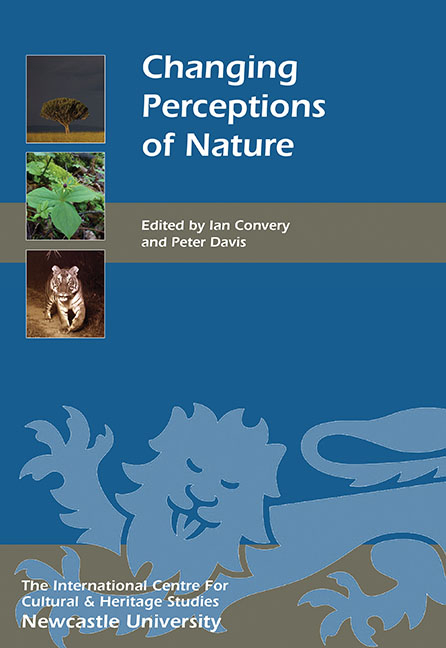Book contents
- Frontmatter
- Contents
- List of Illustrations
- Acknowledgments
- List of Abbreviations
- Foreword
- Introduction
- HISTORICAL PERSPECTIVES ON NATURE
- 1 ‘The Nomination of the Visible’: William Turner's Practice of Natural History
- 2 Early European Perceptions of the Nature of Australia
- 3 Conserving Natural Heritage: Shifting Positions of Culture and Nature
- 4 Three Birds of a Feather – Darwin, Wallace and Attenborough: An Unbroken Tradition of Finding Where the Wild Things Are
- 5 Organising, Naming and Ordering Nature
- 6 Our ‘Great Entail’: Constructing the Cultural Value of the Lake District
- COLLECTING NATURE
- INTERPRETING NATURE AND LANDSCAPES
- CONSERVING NATURE
- PEOPLE–NATURE INTERACTIONS
- List of Contributors
- Index
- Miscellaneous Endmatter
3 - Conserving Natural Heritage: Shifting Positions of Culture and Nature
from HISTORICAL PERSPECTIVES ON NATURE
Published online by Cambridge University Press: 26 October 2017
- Frontmatter
- Contents
- List of Illustrations
- Acknowledgments
- List of Abbreviations
- Foreword
- Introduction
- HISTORICAL PERSPECTIVES ON NATURE
- 1 ‘The Nomination of the Visible’: William Turner's Practice of Natural History
- 2 Early European Perceptions of the Nature of Australia
- 3 Conserving Natural Heritage: Shifting Positions of Culture and Nature
- 4 Three Birds of a Feather – Darwin, Wallace and Attenborough: An Unbroken Tradition of Finding Where the Wild Things Are
- 5 Organising, Naming and Ordering Nature
- 6 Our ‘Great Entail’: Constructing the Cultural Value of the Lake District
- COLLECTING NATURE
- INTERPRETING NATURE AND LANDSCAPES
- CONSERVING NATURE
- PEOPLE–NATURE INTERACTIONS
- List of Contributors
- Index
- Miscellaneous Endmatter
Summary
INTRODUCTION
In this chapter we give an overview of the changing social perceptions of society's relationship with natural resources. We begin in a medieval setting, and while this is essentially an arbitrary starting point, it does highlight the long-held belief in an external influence being responsible for the creation and maintenance of all elements of the natural world. At that point in time, religious thought viewed society as external to a non-human natural world; a position of theism was maintained. In contrast, this review ends at a time of an increasingly secular and utilitarian society, a time in which the dominant view of the natural world is communicated using the economic language of commodification and monetisation.
The process of social change is presented as discrete and simplistic steps; however, history does not exist as a series of themed events conveniently grouped in time and space. With thoughts of the natural world in mind, boundaries between paradigms should be seen as fuzzy, permeable and overlapping, similar to the idea of a social [eco]tone. Landscape, when described as a time and place in which we live, can be seen as the contingent and historically variable result of an interconnected relationship between socio-economic and bio-physical forces. The landscape of our natural heritage is both shaped and defined by culture and its relationship with nature. This position reflects a respect for the capacity of nature to reproduce the Earth's life-support systems. In this sense the ethical perspective is holistic; culture and nature occupy the same space. Nature is seen as a necessity for the existence of human culture, where all human understanding, experiences and activities are played out in the same biophysical processes as are the activities of all other organisms.
We compare the varied temporal, linear views of nature to explore the raltionships between nature and culture. This approach sees society's relationship with the natural world move from an Aristotelian teleological position, where religious thought views society as external to a nonhuman natural world (Hamilton 2002), to the placing of a secular society firmly within a socialecological system (Pickett et al 2005). Here society occupies a place within the natural world, a reflexive component of a complex adaptive social-ecological system (ibid).
- Type
- Chapter
- Information
- Changing Perceptions of Nature , pp. 27 - 36Publisher: Boydell & BrewerPrint publication year: 2016

